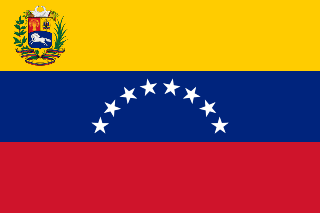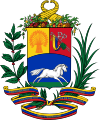
The national flag of the Plurinational State of Bolivia was originally adopted in 1851. The state and war flag is a horizontal tricolor of red, yellow and green with the Bolivian coat of arms in the center. According to one source, the red stands for Bolivia's brave soldiers, while the green symbolizes fertility and yellow the nation's mineral deposits.

The coat of arms of the Argentine Republic or Argentine shield was established in its current form in 1944 but has its origins in the seal of the General Constituent Assembly of 1813. It is supposed that it was chosen quickly because of the existence of a decree signed on February 22 sealed with the symbol. The first mention of it in a public document dates to March 12 of that same year, in which it is stated that the seal had to be used by the executive power, that is, the second triumvirate. On April 13 the National Assembly coined the new silver and gold coins, each with the seal of the assembly on the reverse, and on April 27 the coat of arms became a national emblem. Although the coat of arms is not currently shown on flags, the Buenos Aires-born military leader Manuel Belgrano ordered to paint it over the flag he gave to the city of San Salvador de Jujuy, and during the Argentine War of Independence most flags had the coat of arms.

The coat of arms of Bolivia has a central cartouche surrounded by Bolivian flags, cannons, laurel branches, and has an Andean condor on top.

The national flag of Ecuador, which consists of horizontal bands of yellow, blue and red, was first adopted by law in 1835 and later on 26 September 1860. The design of the current flag was finalized in 1900 with the addition of the coat of arms in the center of the flag. Before using the yellow, blue and red tricolor, Ecuador's former flag had three light blue stripes and two white stripes with three white stars for each province of the country. The design of the flag is very similar to those of Colombia and Venezuela, which are also former constituent territories of Gran Colombia. All three are based on a proposal by Venezuelan General Francisco de Miranda, which was adopted by Venezuela in 1811 and later Gran Colombia with some modifications. There is a variant of the flag that does not contain the coat of arms that is used by the merchant marine. This flag matches Colombia's in every aspect, but Colombia uses a different design when her merchant marine ships are at sail.

The Flag of Peru, often referred to as The Bicolour was adopted by the government of Peru in 1825, and modified in 1950. According to the article 49 of the Constitution of Peru, it is a vertical triband with red outer bands and a single white middle band. Depending on its use, it may be defaced with different emblems, and has different names. Flag day in Peru is celebrated on 7 June, the anniversary of the Battle of Arica.

The current national flag of Venezuela was introduced in 2006. The basic design includes a horizontal tricolour of yellow, blue, and red, dating to the original flag introduced in 1811, in the Venezuelan War of Independence.

The coat of arms of Colombia contains a shield with numerous symbols. Perched on top of the shield is an Andean condor holding an olive crown and the condor symbolizing freedom. The national motto, Libertad y Orden, is on a scroll in between the bird and the shield in black font over golden background. The condor is depicted as displayed and looking to the right.

The coat of arms of Portugal is the main heraldic insignia of Portugal. The present model was officially adopted on 30 June 1911, along with the present model of the Flag of Portugal. It is based on the coat of arms used by the Kingdom of Portugal since the Middle Ages. The coat of arms of Portugal is popularly referred as the Quinas.

In Article 18 of the Law on the National Arms, Flag, and Anthem there is a listing of dates that the Mexican flag is flown by all branches of government. Civilians are also encouraged to display the national flag on these days. Many of the dates listed in the law denote significant events and people that shaped of Mexican identity and the course of its History. Some of the holidays and commemorations listed require the flag to be flown at half-staff. The national flag can be flown any day of the year by civilians or at festive occasions in persurrence to Article 15 of the Law on the National Arms, Flag, and Anthem.
The Law on the National Coat of Arms, Flag and Anthem is a set of rules and guidelines passed by the Mexican government on the display and use of the flag (bandera), coat of arms (escudo) and the anthem (himno). The original law was passed in 1984 and it contains 7 chapters, a preamble and a section that contains the lyrics of the national anthem. The law itself was changed several times, most recently in 2005.

The coat of arms of Peru is the national symbolic emblem of Peru. Four variants are used: the coat of arms per se, the National Coat of Arms, the Great Seal of the State, and the Naval Coat of Arms.

The national flag of Mexico is a vertical tricolor of green, white, and red with the national coat of arms charged in the center of the white stripe. While the meaning of the colors has changed over time, these three colors were adopted by Mexico following independence from Spain during the country's War of Independence, and subsequent First Mexican Empire.

Dexter and sinister are terms used in heraldry to refer to specific locations in an escutcheon bearing a coat of arms, and to the other elements of an achievement. Dexter indicates the right-hand side of the shield, as regarded by the bearer, i.e. the bearer's proper right, and to the left as seen by the viewer. Sinister indicates the left-hand side as regarded by the bearer – the bearer's proper left, and to the right as seen by the viewer. In vexillology, the equivalent terms are hoist and fly.
Most Mexican states do not have an official flag. For these states, a de facto flag is used for civil and state purposes. State flags of Mexico have a 4:7 ratio and typically consist of a white background charged with the state's coat of arms.

The flag of Aragua, one of the 23 states of Venezuela is a bicolor red and yellow banner, divided into four triangles. The upper and lower triangles are red, the left and right triangles are yellow. The red represents strength, valor, fidelity, joy and the honour to heroes of the independence struggle. The yellow colour represents the tropical climate of the state and its noble and charitable spirit. In the centre of the flag there is there is the Aragua state coat of arms. The coat of arms includes the image of a woman carrying a laurel wreath and a palm leaf, a saman tree and a burning house. At the bottom of the coat of arms there are inscriptions stating "Febrero de 1814" and 'Marzo de 1814'.

The coat of arms of Buenos Aires Province was declared official on the 19th of October 1935, by Law 4351. It is similar to the arms of Argentina and has its origins in the seal of the General Constituent Assembly of 1813.

The coat of arms of Gran Colombia was adopted in 1821.

The coat of arms of Yucatán is a symbol of the Free and Sovereign State of Yucatán.

The coat of arms of Querétaro is a symbol of the Free and Sovereign State of Querétaro in Mexico.

































